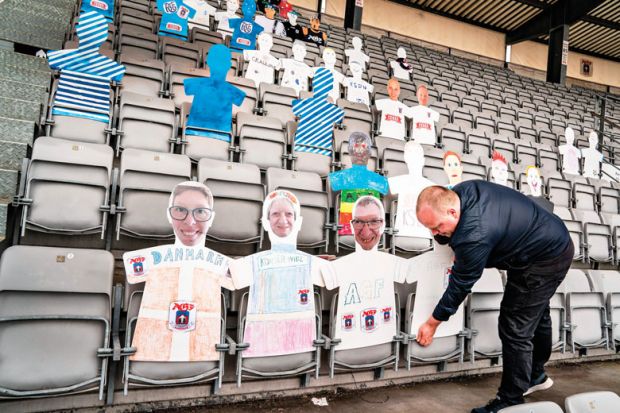When Chiara Bruckmann was finally allowed back into her laboratory after a two-month lockdown, the Milan-based molecular biologist had little time to worry about social activities.
“We were just happy to be back again in the lab,” recalled Dr Bruckmann, a postdoctoral researcher at the Italian Foundation for Cancer Research’s Institute of Molecular Oncology, of her return in May.
“We were all very behind with experiments and as most of the postdocs have short-term contracts, they must produce as much as possible in the limited time they have left,” she said.
Five months on, however, Dr Bruckmann admits the lack of opportunities to socialise with her colleagues is starting to be felt. Lab meetings that were once held in the same room have gone online, seminars with external speakers have been cancelled and social events organised by the postdoc association, which Dr Bruckmann has previously run, have disappeared.
“We are only authorised to take off our face masks during lunch breaks, and a huge of number of people, including myself, consume our lunches alone every day,” added Dr Bruckmann, who said the restrictions on everyday contact are especially hard for postdocs, who typically live away from their family or even their home country.
While Dr Bruckmann is philosophical about the new arrangements – reflecting that they represent a “compromise to keep on working in the lab and to allow our colleagues to work safely” – others are worried the sense of community and camaraderie that sustains many labs is severely under stress.
So, in these socially distanced times, what can be done to build a sense of togetherness in a lab?
Build a structure to support collaboration
“Smaller teams are suffering more than big groups, which tended to have a structure in place to make sure people speak to each other,” said Lee Cronin, Regius chair of chemistry at the University of Glasgow, who manages a team of 65 researchers across six research groups. “I’m really worried that we’re losing that team togetherness, so it helps to build a structure to ensure people overlap in the way they once did.”
Even simple daily check-ins with research group leaders are enough to prevent lab members from becoming too disconnected, he said. “My PA is setting up meetings each day in which I will meet four other group members randomly selected by an algorithm – I don’t know who is in the meeting until I log in,” he explained, saying the five-person limit on attendees has helped to facilitate more creative interactions than did the larger Zoom calls that occurred in lockdown.
Don’t monologue at your team
Larger workshops with 12 team members have also been organised, with staff encouraged to swap ideas and suggest opportunities to collaborate.
To achieve this genuinely creative interaction, however, Professor Cronin said, he has forced himself to step back from leading discussions where possible.
“This virus has not stopped me having ideas, but I do tend to monologue a lot and people’s minds start to drift,” he admitted. “Instead, I’ve tried to go round the team to ask people what they think and act as a facilitator of discussion.”
Face-to-face and large group sessions are also important
With three new postdocs joining his team since lockdown began, Professor Cronin has also held Covid-secure in-person meetings. “Some people are nervous about coming into the lab, but others are desperate to get back, so it’s difficult to strike the right balance,” he said.
And while these small meetings are important, Professor Cronin is keen to arrange large all-team meetings, too.
“We normally have an annual retreat for a few days where we will break up into teams to discuss things and I will pay for dinner and some drinks…That can’t happen any longer, so I am going to try something involving chocolate, tea drinking and Zoom so that everyone can share the same experience together after their breakout sessions,” explained Professor Cronin, who says he has borrowed the idea from Jeremy Baumberg, director of the NanoPhotonics Centre at the University of Cambridge’s Cavendish Laboratory.
“The chocolate tasting worked really well – people spent hours together after the talk, tasting, chatting and nibbling more chocolate,” Professor Baumberg told Times Higher Education, adding that he has also trialled team-building methods during his weekly research group meetings on Zoom, which usually involve about 30 people.
Annual events now being held online also requires research group leaders to think more creatively, added Professor Baumberg.
“We are running a meeting soon that replaces our WinterSchool, when we normally spend a week brainstorming away from everything and getting to know each other socially by doing challenging activities for each of us,” he explained. “Now everyone will give a one-minute talk on the research someone else is doing,” said Professor Baumberg, who added that this “means pairs of researchers have to understand and discuss enough together to be able to present well and then they have to come up with an idea that uses both of their research areas. It has led to some hilarious results and sometimes fabulous ideas.”
Register to continue
Why register?
- Registration is free and only takes a moment
- Once registered, you can read 3 articles a month
- Sign up for our newsletter
Subscribe
Or subscribe for unlimited access to:
- Unlimited access to news, views, insights & reviews
- Digital editions
- Digital access to THE’s university and college rankings analysis
Already registered or a current subscriber? Login







